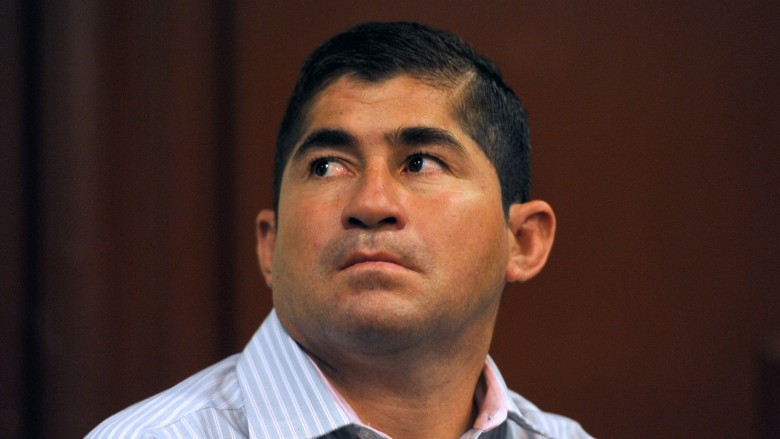How These People Survived The Impossible
If you spend any time at all watching the news, it would be easy conclude it doesn't take much to lose your life: the universe just decides that it's your time, and poof, no more you. It doesn't matter whether you're fat or fit, tall or short, smart or dumb, when your time is up, it's up ... unless you're like these people, who clearly didn't get the memo:
Harrison Okene
Of all the times you could choose to find out whether your boat will double as a submarine, 5 AM while sitting on the toilet probably wouldn't be among your top 100. But unfortunately for Harrison Okene, the cook aboard the tug-boat Jascon 4, that was the reality he faced when his world got turned upside down ... literally.
The boat was working in an oilfield off the coast of Nigeria, when rough seas proved too much and capsized Jascon 4, sending it 100 feet to the bottom. While every other crew member perished, Okene found himself stranded, but alive, using the only pocket of air available to survive the flooding. But it wasn't all a blessing — although he was alive, he was also cold, wet, in complete darkness, wearing nothing but his underwear ... for 3 days! Understandably, rescuers had no reason to assume anyone was alive on the sunken ship — it wasn't until divers eventually visited the ship to recover the bodies that the remarkably not-dead cook was found.
Now, when a person spends time at depth and under pressure, the nitrogen in the air they're breathing dissolves into their body tissues — the longer they're down there, the more that gets dissolved. If they surface too quickly, that nitrogen can suddenly reappear in the form of bubbles in all the wrong places, causing extreme pain and even death. With that in mind, Okene was taken to the surface in a pressurized diving bell, then confined for another two days in a decompression chamber, before he was finally allowed to never go back into a small space ever again.
After the ordeal was over, he reportedly recovered by eating lots of his favorite soup, planning a no-doubt best-selling book, probably steering well clear of boats, and hopefully attending a few professional therapy sessions once in awhile as well.
Coolidge Winesett
Like Harrison Okene, Coolidge Winesett was also stuck in a toilet for three days. Unlike Okene, there was 100 feet of water overhead, but in some ways, Winesett's experience was even worse. It was certainly stinkier.
At the time of the accident, Winesett was a 75-year-old retired janitor, who lived in the home he grew up in in Southwest Virginia. Unfortunately, the property hadn't changed much over the years, and there was no indoor bathroom — just an old outhouse Winesett built himself in 1950. One afternoon in August 2000, he visited it for the last time. After five decades of abuse, the rotting floor boards finally failed, dumping the WWII veteran into the pit. Luckily for him, the remains of the floorboards landed on a sub floor, keeping him from actually landing in the night soil. Unluckily for him, he had been partially paralyzed by a stroke and was missing part of one leg, leaving him physically incapable of climbing back out.
Coolidge lived alone in the old house, and pretty much his only regular visitor was the mailman. It nevertheless took him three days to notice the mail was piling up, at which point he didn't just shrug his shoulders and walk away as many might, but instead decided to investigate. At this point, Coolidge had been stuck in the pit for 69 hours, and although there was no risk of drowning down there, it did come with a good supply of visitors, like spiders, snakes, maggots, and a rat that he actually had a fun, delusional chat with. After being discovered by the mailman, neighbors and the fire department were able to rescue him. Mr Winesett was obviously something of a religious man, because he admitted after being rescued, he spent a lot of time in the pit wondering what he had done to deserve the suffering ... other than not install an indoor toilet, obviously.
Matthew Croucher
Soldiers bravely jumping onto grenades to protect their friends is something of a movie trope, but when it happened in real life, it had something of a happier ending.
Matthew Croucher was serving with the British Royal Marines in Afghanistan in 2008, when he took part in a raid on a suspected bomb factory. During the search he felt something press against his leg — a moment later, he saw a grenade hit the floor by his feet. After shouting a warning to the other members of his patrol, Croucher proved that he watched too much TV by jumping onto the grenade, which soon exploded.
Miraculously, no one was hurt, not even Croucher, because not long after he landed on the grenade face-first, he rolled over and pinned the grenade to the ground under his backpack and body armor, tucking his legs to his chest in the process. When the grenade exploded, the lance corporal was thrown across the room, his backpack shredded and ablaze, and his body armor and helmet peppered with grenade fragments. He himself, however, walked away with nothing more than a headache, a nosebleed, and probably free pints for life from all the marines who didn't jump on a grenade that day.
Truman Duncan
There are members of the animal kingdom, like earthworms and geckos, that can lose a major portion of their bodies and shrug it off like a boss, but until now, that list hasn't included humans. Enter one Truman Duncan, railway worker in Texas, who was riding on the front of a train car when he suddenly lost his grip. Despite a futile attempt to run backwards away from the onrushing train, he fell on the tracks, and was dragged under the wheels.
At this point, the news report usually lists the grieving next of kin, but not this time. Despite being almost literally cut in two, he made the decision not to die. He decided to keep himself awake, keep himself talking, and because he's clearly the nearest thing a human can be to the Terminator, he called his own ambulance too. It worked: an hour after the accident, he finally made it to a hospital, where surgeons began work on the first of 23 surgeries to make the biggest piece they could of the parts they had to work with.
Now, despite being minus large parts of his walking mechanism, he is alive, back at work at the railyard (in an office though, no longer chasing trains), and with a story he can only tell in the company of Pinocchio, lest people think he's making the whole thing up on the spot.
Ron Hunt
Think being stabbed in the brain is a sure fire way to meet your maker? Ron Hunt might have something to say about that. In a freak accident that might bear a scary similarity to that nightmare you had that one time, Ron was up a ladder operating an industrial drill with an 18-inch-long bit, when suddenly the ladder fell out from under him. As he plummeted to the ground, he naturally let go of the drill — the two were soon reunited in a very unpleasant way. As he fell face-first, he actually landed directly onto the upturned bit, which had pierced his right eye socket, passed straight through his head, and come out the other side just behind his right ear.
Yet, despite having a large industrial tool embedded in his brain, Ron was awake and alert enough to both realize what happened and get upset about it, at which point his co-workers took over and called the emergency services. Upon arriving at the hospital and receiving a shot of morphine, Ron rapidly recovered his sense of humor, which we assume was controlled by the part of his brain with the drill through it, because he decided this was a "Kodak moment"—he wasn't wrong, but still.
According to ABC News, a surgeon called Dr. Paul Ludlow ended up removing the drill. However what started out like an actual surgical operation, ended up more like the board game Operation, because as they started trying to cut the drill, they noticed it was loose in Hunt's head, so they stopped cutting and started unscrewing. The drill was successfully removed and, despite the loss of his right eye, Ron Hunt seems none the worse for the experience. This is because, according to Dr. Ludlow, the drill didn't actually penetrate the brain — miraculously, it just pushed it aside as it passed through the skull, leaving minimal damage. He probably heard a few jokes about that.
Vesna Vulovic
In 1972, Vesna Vulovic was a flight attendant aboard an airliner that exploded over Czechoslovakia at 33,000 feet. The plane was totally destroyed, leaving Vulovic and the other passengers and crew with a really great and unobstructed view of the ground ... plus the time it takes to fall 6 miles to appreciate it.
After gravity had it's say, Vulavic was the only one left alive. When she was found, she was partially buried under debris and bodies, had broken both legs, crushed three vertebrae, and suffered a severe head injury. When they arrived at the hospital, her parents were even told that there was no hope and she would most likely die ... but she didn't. In fact, she eventually awoke from her coma and, after asking for a cigarette, went to work learning to walk again, which she did.
Her amazing survival came down to how she didn't face the fall alone, but instead took the plunge attached to a piece of the aircraft, wedged between another crewmember and a food cart. When this collection of parts hit the ground, it was fortunate to hit a snow-covered slope and slide some distance before coming to a rest. This all helped to cushion and distribute the force of an otherwise-unsurvivable freefall. So next time you travel by air ... just don't think about bombs and falling 30,000 feet — it probably won't happen, and it'll only ruin your movie.
Anatoli Bugorski
The 1978 award for the most sci-fi near death experience goes to Anatoli Bugorski, who was shot through the head with a particle beam, and survived.
In the 1970s, Bugorski was part of a Soviet research program that was working with a particle accelerator. The once where Bugorski worked is called the U-70 — at the time, it was the most powerful accelerator in the world, except for on July 13, 1978, when it malfunctioned. Bugorski was sent to check on it, and while he was getting up close and personal with the science experiment, something went wrong and his head got in the way of the particle beam. The beam entered his head on the back left, and passed through exiting to the left of his nose. He reported seeing a bright flash ... and that's it. There was no explosion, no screaming — just your standard real world science accident.
A few days later, the left side of his face had swollen up, and the skin and hair around the entry and exit points had peeled off. However, despite being hit by enough radiation to convince doctors he was a goner, he pulled through. Bugorski survived because, in order to maximize the number of collisions in the accelerator, the proton beams are very focused. Though the beam had tremendous power, it only affected the very small area of the brain that it actually passed through. It also helped that the beam appears to have missed the really important parts, and the brain is so good at adapting to injury, his was able to rewire itself well enough that he was later able to complete his PhD.
Now, if this were a movie, he might have gained superpowers from all this. However, since actual science isn't nearly as cool, he had to settle with the not-very-useful superpower of having no feeling in the left side of his face. The nerve damage he received on the left side of his face caused paralysis, so even after nearly 30 years, it has almost no wrinkles. This makes him both Dorian Gray and the picture of Dorian Gray, all in one convenient package.
Anna Bågenholm
If a person's heart isn't beating, they're not breathing, and their body temperature is 40 degrees below normal, you would probably go ahead and call them dead. And before Anna Bågenholm fell into a frozen stream while skiing in Norway in 1999, most doctors would have agreed ... afterwards, not so much.
After she fell through the ice, and her friends were unable to immediately pull her back out, she was lucky to find an air-pocket that allowed her to keep breathing for around 40 minutes. Unfortunately, despite the air supply, the water was still ice-cold, and before too long she stopped moving. By the time she was finally freed, she had been under the water for 80 minutes, and gave every impression of being dead.
Fortunately for her, her friends weren't quite ready to give up, and so they performed CPR on her anyway. Nearly three hours after her day got memorable she finally arrived at a hospital, with her body temperature at an insane 56.7 degrees Fahrenheit (it should be 99.5), and the electrocardiogram she was hooked up to had nothing at all to say. But the doctor decided that, since she had received continuous CPR since she was recovered, it was worth waiting until she warmed up a bit before declaring her stone-cold dead. So they warmed her up slowly by circulating her blood out of her body, heating it slightly, then pumping it right back in. Nothing happened for almost a full day, but then at 4 PM the following day, her heart started beating on its own — twelve days after that she woke up, on course for a full and totally miraculous recovery.
Bågenholm's survival was down to how she froze before she drowned. This meant her metabolism had a chance to slow down, reducing the amount of oxygen the brain needed to survive until her friends could start CPR. As a result of this event, when presented with someone who appears to have frozen to death, it's now common practice to continue CPR, and warm the patient up thoroughly before covering them with a sheet.
Fabrice Muamba
Just because you're a professional sportsman, with fitness levels rarely approached by the rest of us, doesn't mean you're immune to illness. Fabrice Muamba, a professional soccer player in the UK, learned that in 2012. Muamba was 43 minutes into a 90-minute match at a stadium in North London, when cardiac arrest stopped his heart — he collapsed on the spot.
Luckily for him, of all the places he could have chosen for this to happen, the only place better would be actually inside a specialist heart unit, because within seconds of his collapse, he was surrounded by medical personnel who started CPR. Also attending the game that day was Doctor Andrew Deaner, who actually worked in the nearest specialist heart unit — after talking his way onto the pitch, he quickly decided that Muamba needed to be taken directly to his hospital, rather than the closer default option. Luckily for Muamba, Dr. Deaner was able to convince the ambulance drivers, who raced eight miles across London and delivered him directly into the waiting hands of Deaner's specialists. At 7:31 PM, 78 minutes after he collapsed, his heart was successfully restarted.
Before he reached the hospital, in an attempt to kickstart his heart, Muamba was given a total of 15 electric shocks from a defibrillator. That's not exactly a pleasant experience, and it says something for his strength that he came through that as well. Two days after he collapsed, he awoke in intensive care — as well as recognizing his fiancee, he was reportedly upset his collapse caused the game to be abandoned. But it's hardly surprising, since cardiac arrest is a pretty hard act to follow.
Salvador Alvarenga
Salvadore Alvarenga was a fisherman working in Mexico in November 2012, when he decided to head out to sea and catch some fish. Taking with him a novice deckhand named Ezequiel Córdoba, Alvarenga headed out to sea in his open-top boat, loaded down with fishing gear. Everything was going fine, until a storm hit that was so wild, they had to cut loose their fishing lines to avoid sinking. They tried to sail the 75 miles back to land ... and they almost made it. With just 15 miles left the engine cut out and wouldn't restart, and the boat was blown back, away from land, and out into the wide and empty Pacific Ocean. Alvarez wouldn't be seen again for 438 days — Córdoba just won't be seen again.
Although at first they were able to collect rainwater, for large parts of the journey they were sustained by drinking raw blood and meat from sea turtles and seabirds — while Alvarenga was able to keep this up, the definitely-not-for-the-squeamish diet soon took take its toll on Córdoba, who ate less and less until eventually, he died. Alvarenga continued on, hunting birds and catching fish, watching the sunrise, and getting a change of scenery by going for "relaxing" shark-infested swims. He also thought about his estranged daughter, and what he would do with his life if he ever survived his ordeal.
Then on January 30 2014, alerted by seabirds and floating coconuts—because sometimes stereotypes actually happen—Alvarenga realized he was approaching an island. Half a day later, after a journey of 5000 miles, he washed ashore on one of the most remote islands in the Pacific, the last spot of land for another 3000 miles. It's a story of incredible bad luck, and simultaneously of incredible good luck ... plus, the wisdom of carrying a spare engine always.








